A Spiritual Journey Through Sacred Sites in Nepal
Nestled in the heart of the Himalayas, Nepal is not just a haven for trekkers and adventurers; it is a land deeply woven with spiritual threads that draw pilgrims and seekers from around the world. From the serene birthplace of Lord Buddha to the mystical temples perched atop rugged hills, Nepal's sacred sites offer a unique blend of tranquility, history, and divine energy. Each site tells a story, echoing the chants of monks, the prayers of devotees, and the whispers of ancient legends. Join Tweet Tours on our journey through Nepal’s most revered sacred sites, where the spiritual and the natural worlds converge in breathtaking harmony.
Nepal
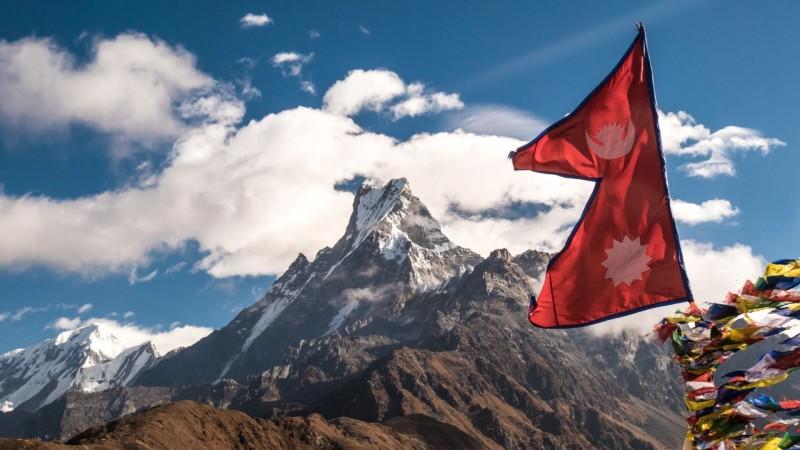
10 Sacred Sites in Nepal for Your Next Spiritual Escape
1. Lumbini – Lord Buddha's birthplace
Lumbini, a UNESCO World Heritage Site, is revered as the birthplace of Siddhartha Gautama, who later became the Buddha. Located in the Rupandehi District of Nepal, Lumbini is a significant pilgrimage site for millions of Buddhists worldwide. According to ancient texts, Queen Maya Devi gave birth to Buddha in the gardens of Lumbini while traveling to her parental home. The centerpiece of Lumbini is the Maya Devi Temple, which enshrines the exact spot where Buddha was born. Nearby, the sacred Bodhi tree and the Ashoka Pillar, constructed by Emperor Ashoka in 249 BC, stand as testaments to the site's historical importance.
Visitors to Lumbini often describe a profound sense of peace and reverence. The monastic zone, divided into eastern and western monasteries, showcases architectural styles from various Buddhist traditions. As you stroll through the tranquil gardens, you may encounter monks in meditation or pilgrims chanting prayers, creating an atmosphere of serene devotion.
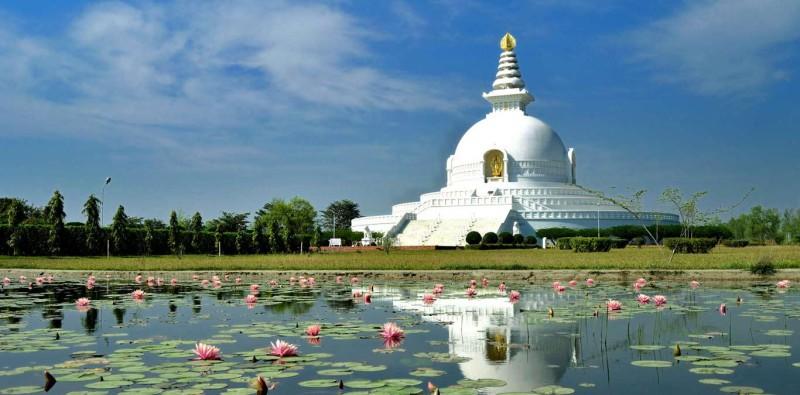
Lumbini – Lord Buddha's birthplace
2. Pashupatinath Temple
Pashupatinath Temple, located on the banks of the Bagmati River in Kathmandu, is one of the most revered Hindu temples devoted to Lord Shiva. It is renowned for its awe-inspiring architecture and spiritual significance, attracting thousands of pilgrims each year, especially during the Maha Shivaratri festival. Located in Kathmandu Valley, a UNESCO World Heritage Site, the temple complex includes numerous smaller temples, ashrams, and inscriptions that date back centuries.
The main temple's pagoda-style architecture, with its richly ornamented silver doors and intricate wood carvings, is a visual marvel. The sanctum houses the sacred lingam of Pashupatinath, believed to be an incarnation of Shiva. One of the most compelling aspects of Pashupatinath is the evening aarti, a ritualistic prayer accompanied by the rhythmic sounds of bells and drums, which captivates visitors with its spiritual intensity.
Local historians and residents often share tales of the temple's miraculous origins and its role in the cultural and religious tapestry of Nepal. As you walk along the ghats, you witness sadhus (holy men) performing rituals and offering blessings, adding to the temple's mystical allure.
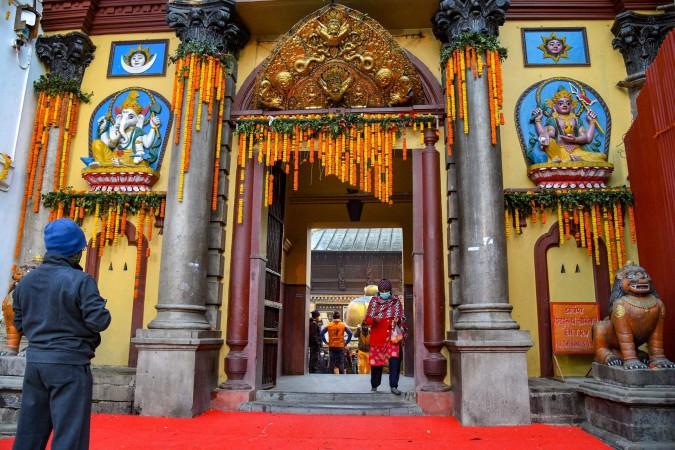
Pashupatinath Temple
3. Swayambhunath Stupa (Monkey Temple)
Perched atop a hill overlooking Kathmandu Valley, Swayambhunath, also known as the Monkey Temple, is a sacred Buddhist site that offers panoramic views of the city below. This ancient stupa is one of the oldest and most revered in Nepal, its origins shrouded in legend. According to mythology, the site was self-created from a primordial lake that once covered the valley, with the stupa symbolizing the spontaneous creation of the universe.
The central stupa, adorned with a golden spire and the iconic eyes of Buddha, is surrounded by a plethora of shrines, temples, and prayer wheels. The air is filled with the scent of incense and the sound of prayer flags fluttering in the wind. Monkeys, considered holy and protected, roam freely around the complex, adding to the site's unique charm.
Swayambhunath is a melting pot of religious harmony, where both Buddhists and Hindus come to worship. You will hear many fascinating stories about the stupa's history and the significance of various rituals performed here. The experience of climbing the 365 stone steps to the stupa, with the Kathmandu Valley unfolding beneath you, is both a physical and spiritual ascent.
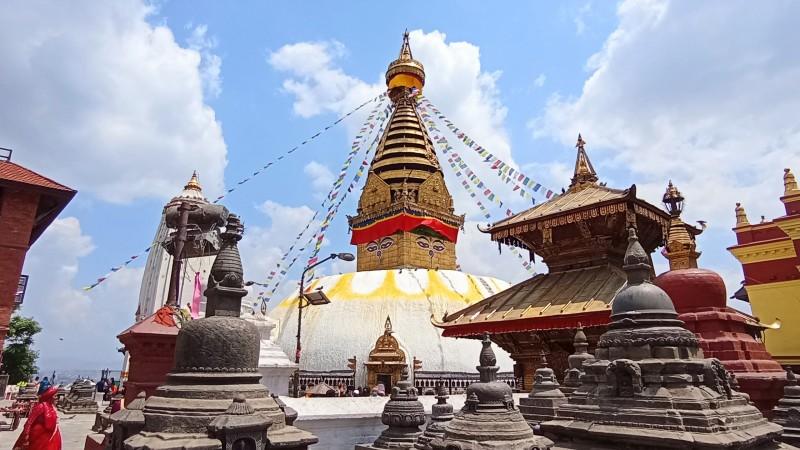
Swayambhunath Stupa (Monkey Temple)
4. Muktinath Temple
Nestled at an altitude of 3,710 meters in the Mustang district, Muktinath Temple is a revered pilgrimage site for both Hindus and Buddhists. The temple, known for its remote and rugged beauty, is believed to be a place of liberation or "moksha," where devotees seek freedom from the cycle of birth and rebirth. The name Muktinath itself translates to "place of salvation," and this sacred site is an integral part of the Annapurna Circuit, a popular trekking route in Nepal.
The main shrine is a pagoda-style temple dedicated to Lord Vishnu, surrounded by 108 water spouts in the shape of bull heads. Pilgrims traditionally bathe under these spouts, which are fed by a natural spring, to purify themselves. Another fascinating feature is the eternal flame that burns from natural gas, considered a miraculous element by the devotees.
You will often hear many stories shared by other visitors about their spiritual encounters and the challenging yet rewarding journey to reach Muktinath. The panoramic views of the Himalayas, the unique cultural blend of Hindu and Buddhist practices, and the serene environment make Muktinath a profoundly spiritual destination.
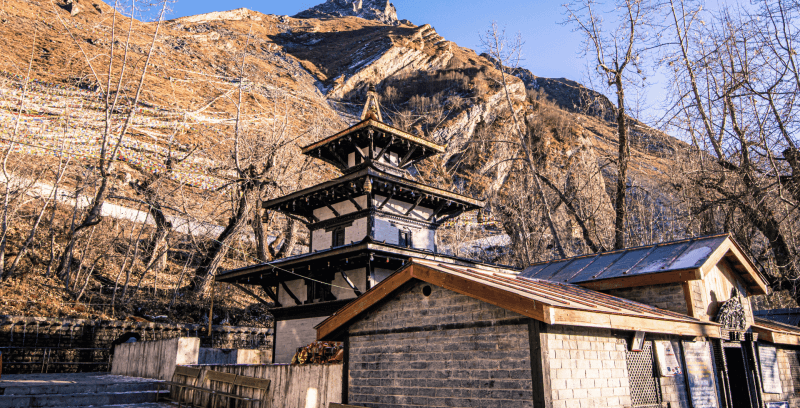
Muktinath Temple
5. Manakamana Temple
Manakamana Temple, dedicated to the wish-fulfilling goddess Bhagwati, sits atop a hill in the Gorkha district. This venerated temple is accessed via a thrilling cable car trip with breathtaking views of the surrounding hills, rivers, and Himalayan range. The name Manakamana is derived from two words: "mana" meaning heart and "kamana" meaning wish, implying that the goddess grants her devotees' sincere requests.
The temple has a rich history linked to the Gorkha royal family and is a significant pilgrimage site, especially during the Dashain festival when it sees a surge in visitors. The temple complex itself is an architectural marvel, with intricately carved woodwork and a serene courtyard where devotees gather to offer prayers and sacrifices.
Local legends tell of miraculous wish fulfillments, and many pilgrims return to the temple to express gratitude for their granted wishes. The combination of spiritual significance, historical importance, and the adventurous journey to the temple makes Manakamana a unique and compelling destination.
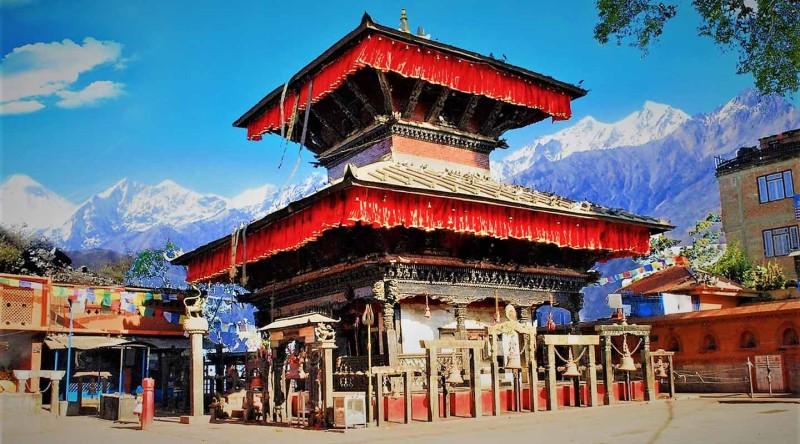
Manakamana Temple
6. Janaki Mandir
Located in the historic city of Janakpur, Janaki Mandir is an exquisite example of Mughal and Koiri architecture dedicated to Goddess Sita, the wife of Lord Rama. This majestic white marble temple was built in 1910 by Queen Vrisha Bhanu of Tikamgarh and stands as a symbol of love and devotion. It is one of the most important holy locations for Ramayana devotees, who read about Lord Rama and Sita's lives and adventures.
The temple complex is adorned with beautiful domes, turrets, and intricate latticework, creating an ethereal ambiance. It is especially vibrant during the festivals of Ram Navami and Vivah Panchami, which celebrate the birth of Lord Rama and the divine marriage of Rama and Sita, respectively. Thousands of pilgrims from India and Nepal flock to Janaki Mandir to participate in these grand celebrations.
You can explore the various halls and courtyards of the temple, where priests perform daily rituals and devotees sing hymns in praise of Sita and Rama. The nearby Janakpur Dham also offers several other temples, ponds, and historical sites related to the ancient city of Mithila, enriching the cultural experience.
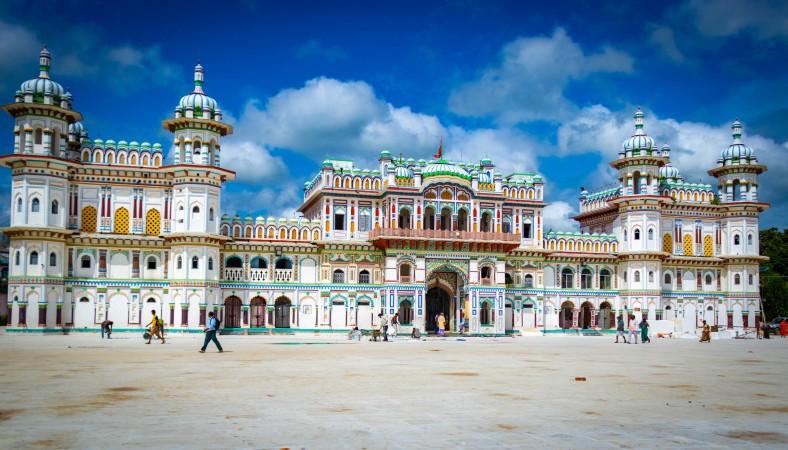
Janaki Mandir
7. Tengboche Monastery
Tengboche Monastery, located at an elevation of 3,867 meters in the Khumbu area, is one of Nepal's most prominent Buddhist monasteries. It offers breathtaking views of Mount Everest, Ama Dablam, and other towering peaks, making it a spiritual haven for trekkers and pilgrims alike. Established in 1916 by Lama Gulu, the monastery is a center of Tibetan Buddhist practices and Sherpa culture.
The monastery is renowned for its vibrant annual festival, Mani Rimdu, which features masked dances, prayers, and elaborate ceremonies. This festival, held in October or November, draws visitors who wish to witness the unique blend of spirituality and cultural tradition. The monastery also serves as a crucial stop on the Everest Base Camp trek, providing a serene place for trekkers to rest and reflect.
Inside the monastery, visitors can admire the intricate murals and statues, and often hear the chanting of monks during prayer sessions. The surrounding area is dotted with prayer flags, chortens, and mani stones, enhancing the spiritual atmosphere. Tengboche Monastery's combination of natural beauty, religious significance, and cultural richness makes it a must-visit destination in Nepal.
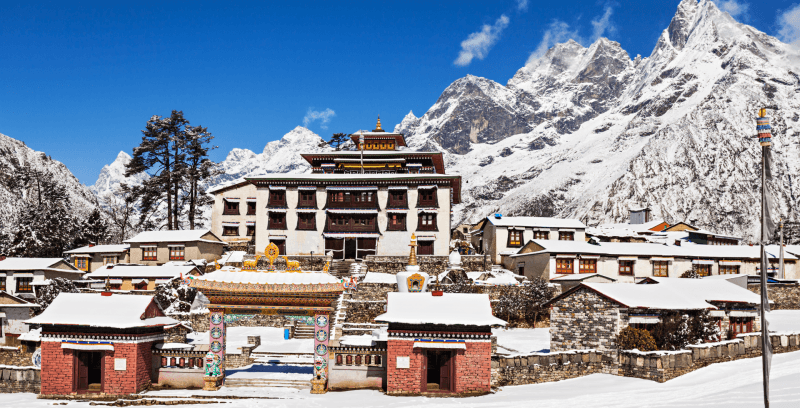
Tengboche Monastery
8. Budhanilkantha Temple
Budhanilkantha Temple, located at the base of the Shivapuri Hill in Kathmandu, is one of the most significant Hindu temples dedicated to Lord Vishnu. The temple is renowned for its striking statue of Lord Vishnu reclining on the coils of the cosmic serpent Shesha. This remarkable stone statue, believed to be over 1,400 years old, is the largest of its kind in Nepal and appears to be floating on the water of a sacred pond.
The temple draws believers and visitors alike, especially during the Haribodhini Ekadashi festival, which commemorates Lord Vishnu's waking from his cosmic hibernation. Local legends and myths abound regarding the origins of the statue, with some believing it was created by a divine craftsman who was guided by a dream. The serene environment of the temple, combined with the captivating sight of the deity in repose, offers a peaceful retreat from the bustling city.
You could witness with your own eyes the daily rituals performed by the priests and participate in the various religious ceremonies held at the temple. The nearby hills and forests of Shivapuri Nagarjun National Park add to the allure of Budhanilkantha, making it a perfect destination for both spiritual seekers and nature lovers.
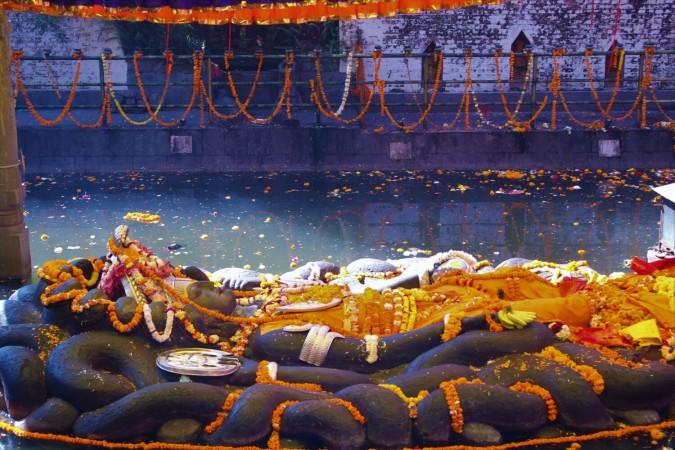
Budhanilkantha Temple
9. Pathivara Devi Temple
Pathivara Devi Temple, located at an elevation of 3,794 meters in the Taplejung district, is one of the most significant religious sites in eastern Nepal. This temple, dedicated to the Goddess Pathivara, draws people from Nepal and neighboring India seeking blessings and the fulfillment of their aspirations. The temple's location in the Kanchenjunga Conservation Area offers visitors not only a spiritual experience but also breathtaking views of the Himalayas and rich biodiversity.
The journey to Pathivara Devi Temple is both challenging and rewarding, often involving a trek through lush forests and rugged terrain. Pilgrims and trekkers alike appreciate the opportunity to immerse themselves in nature while on a spiritual quest. The temple is particularly busy during major Hindu festivals, when devotees come to offer animal sacrifices and other offerings to the goddess.
You will hear numerous stories of miracles and fulfilled wishes shared by the locals, which contribute more to the temple's mystique. The combination of natural beauty, cultural richness, and spiritual significance makes Pathivara Devi Temple a unique destination for those seeking both adventure and divine blessings.
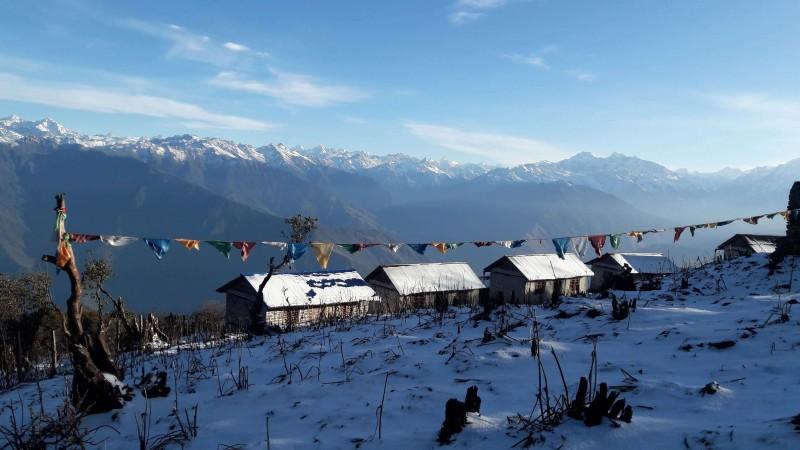
Pathivara Devi Temple
10. Gosaikunda Lake
Gosaikunda Lake, located at an elevation of 4,380 meters in the Rasuwa area, is a holy alpine lake adored by both Hindus and Buddhists. According to Hindu mythology, the lake was created by Lord Shiva when he struck the ground with his trident to obtain water after swallowing poison to save the universe. This lake, surrounded by rugged mountains and pristine landscapes, is part of the Langtang National Park and offers a serene and awe-inspiring setting for pilgrims and trekkers.
The lake is most visited during the Janai Purnima festival in August, when thousands of devotees trek to Gosaikunda to bathe in its icy waters, believing that it will cleanse them of their sins. The challenging trek to Gosaikunda, which passes through lush forests, quaint villages, and steep ascents, is considered a rite of passage for many.
You could recount the spiritual tranquility they feel upon reaching the lake, with its crystal-clear waters reflecting the sky and surrounding peaks. The area around Gosaikunda is also home to several other sacred lakes, collectively known as the Gosaikunda Lakes, each with its own religious significance and natural beauty.
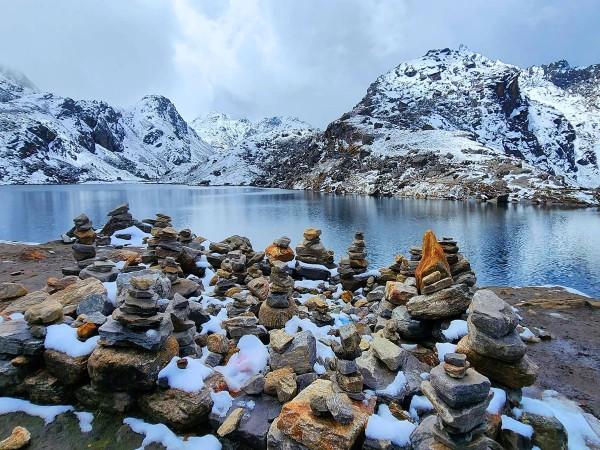
Gosaikunda Lake
Conclusion
The sacred sites of Nepal are more than just places of worship; they are sanctuaries of history, culture, and spirituality. From the peaceful gardens of Lumbini to the craggy hills around Gosaikunda Lake, each location provides a distinct look into Nepal's spiritual core. These destinations invite pilgrims and travelers to embark on journeys of faith, adventure, and self-discovery. Whether you are seeking divine blessings, cultural enrichment, or the simple serenity of nature, the sacred sites of Nepal promise an experience that is both profound and unforgettable. Embrace the spiritual richness of Nepal, and let each sacred site guide you on a path of enlightenment and peace.
Des articles pour vous

Explore Fukushima - Japan Travel, Asia
Nestled in Japan's scenic Tohoku region, Fukushima offers travelers a unique blend of historical charm, cultural richness, and natural beauty. Known for its stunning landscapes and welcoming communities, Fukushima is an excellent destination for those seeking an authentic Japanese experience beyond the bustling metropolises. Renowned for its diverse attractions, from ancient castles and hot springs to vibrant festivals and picturesque countryside, Fukushima offers a great opportunity for cultural and historical exploration for anyone who loves Japanese culture.
Population: Approximately 1.8 million in 2023.
Economy: Specializing in the seafood and fishing industries, Fukushima, with its historical impacts, now continues to thrive as one of the most developed and largest economies in Japan.
Landmarks: Famous for Aizu-Wakamatsu Castle, Fukushima City Historical Museum, and Ouchi-juku.

La symphonie saisonnière de l'Inde : Révéler les meilleurs moments pour explorer le sous-continent
Les traditions anciennes dansent avec les merveilles modernes dans une terre où les épices et l'encens embaument l'air, et chaque recoin cache une histoire prête à être découverte. L'Inde, vaste et diverse, se déploie comme un monde miniature en soi. Mais quand devriez-vous entreprendre ce voyage épique ? Rejoignez-nous pour un tourbillon à travers la tapisserie saisonnière de l'Inde et trouvez le moment parfait pour votre aventure.

Voyage culinaire à travers la Chine : Savourez les saveurs diversifiées
Des rives subtropicales de Canton aux steppes balayées par le vent du Xinjiang, le vaste paysage de la Chine est une tapisserie de saveurs, chaque région mettant en avant ses propres trésors culinaires. Avec plus de 2000 miles séparant les palais de dim sum du sud des étals de kebabs du nord-ouest, et des woks crépitants entre les deux, la diversité gastronomique de la Chine est véritablement inégalée. Alors, prenez vos baguettes et embarquez pour une aventure gourmande à travers les plats les plus délicieux du Royaume du Milieu !

Vivez l'expérience à bord du RV Indochine II - Une croisière sur le Mékong
Le RV Indochine II est un navire de croisière fluviale de luxe, offrant un voyage inoubliable à travers de nombreuses attractions le long du fleuve Mékong. Construit en 2017, ce vaisseau haut de gamme allie élégance coloniale et commodités modernes pour créer un environnement à la fois confortable et élégant pour son équipage et ses passagers. La taille intime du navire en fait le choix idéal pour ceux qui recherchent une expérience de croisière plus personnelle tout en explorant la culture, les paysages et le patrimoine riches du Vietnam et du Cambodge. Que vous admiriez le paysage depuis votre balcon privé ou que vous dégustiez une cuisine locale authentique, le RV Indochine II promet une aventure exotique hors du commun.

Assistez à la pêche sur pilotis au Sri Lanka
Le Sri Lanka, réputé pour ses plages magnifiques et son riche patrimoine culturel, abrite une tradition unique qui captive les voyageurs depuis des siècles : la pêche sur pilotis. Cette pratique ancienne, transmise de génération en génération au sein des communautés côtières, allie art et nécessité, offrant un aperçu d'un mode de vie intimement lié aux rythmes côtiers de l'île. La pêche sur pilotis au Sri Lanka n'est pas simplement un moyen de capturer des poissons ; c'est un emblème culturel, incarnant la résilience et l'ingéniosité des communautés de pêcheurs sri-lankaises.

À l'assaut des sommets : guide du randonneur de l'Himalaya
Lorsque les premiers rayons du soleil teintent les sommets enneigés de doré et de rose, vous êtes au seuil de l'aventure. Bienvenue dans l'Himalaya, où chaque pas est une immersion dans le plus grand spectacle de la nature. Avec Tweet World Travel comme guide, préparez-vous à un trek d’aventures, qui éveillera vos sens et vous transformera à jamais.
